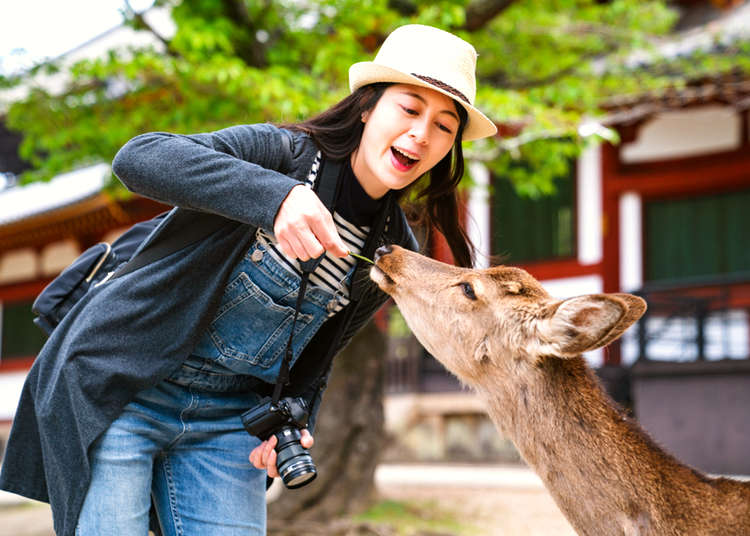
First Time in Nara: Where To Go And What To Do in Japan's Famous City
- Written by: WESTPLAN
Nara City, a former capital city of Japan, is today a tourist destination near Kyoto and Osaka. It has an even older history than Kyoto, and there are a lot of cool Nara sightseeing spots throughout the city.
The number one highlights of the city are the buildings and statues of the shrines and temples, many of which are even registered as world heritage sites, make it one of the finest sightseeing locations in all of Japan.
This article will also introduce the most essential must-try elements of Nara cuisine, as well as Nara's adorable deer-themed souvenirs.
- Table of Contents
-
- What Kind of Place is Nara?
- The Main Nara Sightseeing Points
- Todai-ji Temple's Statue of Buddha and Buildings are Both Extraordinary in Size
- Kasuga Grand Shrine, Established as a Capital Guardian
- Take a Walk Through Naramachi's Historic Merchant Houses
- Persimmon-Leaf Sushi is the Leader of Nara Cuisin
- Food and Japanese Confectionery Using Kuzu
- For Deer-Themed Goods, Go to "je et nous"
- "Archaic", Packed with Deer Sweets Any Girl Will Love
- Book an unforgettable experience in Nara!
What Kind of Place is Nara?

At the center of the former Japanese capital of Nara is the Nara Park area, where Todai-ji Temple, Kofuku-ji Temple, and Kasuga Grand Shrine are located.
You can reach the area from Kyoto or Osaka by taking the JR or Kintetsu Railway lines, about an hour trip. "Nara-machi" is full of historic character, with its untouched streets and shops from the Edo period and many facilities once used by tradesmen.
All over the greater Nara region, you can find countless more highlights, including the mountainside roads said to be the oldest roads in Japan, Yoshino and the world heritage site that is all of Mount Yoshino itself, and the Ikoma and Ikaruga districts which appear even in Japanese mythology.
Because Nara has no ocean and is land-locked on all four sides, its climate is characterized by particularly hot summers and cold winters. The most ideal season is autumn, when tourists visit from all over the country hoping to see Nara's fall foliage and the pieces of culture uniquely seen in the autumn season.
The Main Nara Sightseeing Points
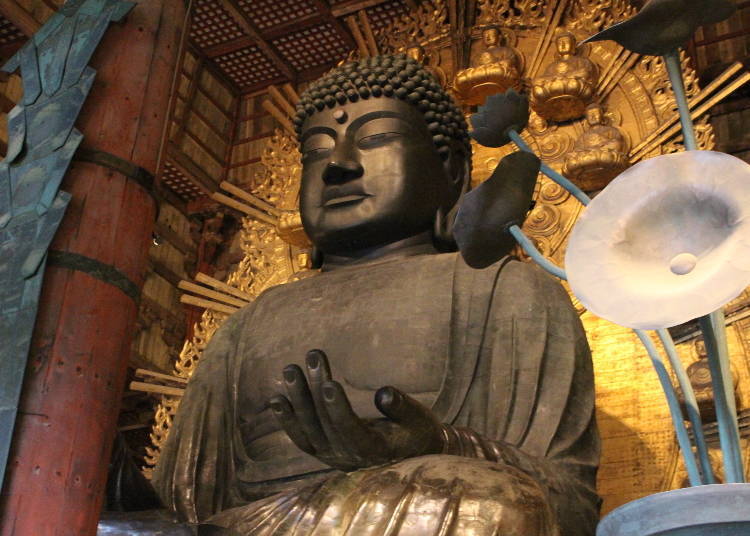
Nara's three large, world heritage site shrines and temples, Todai-ji, Kofuku-ji, and Kasuga-taisha are all concentrated in Nara Park, so you can spend an entire day in the park area alone. Tack on Yakushi-ji and Toshodai-ji Temples in Nishinokyo and Japan's first ever world heritage site Horyu-ji Temple, and you have a recipe for another day of sightseeing.
If you want to head over to Asuka and Yoshino to see the "yama-no-be-no-michi" mountainside roads, you will likely need to add on another whole day. Among the passes sold by Nara Kotsu bus lines are a "one-day pass" which will take you to all the main features in Nara City, the "wide pass" with a broad area of applicable usage, a "two-day pass", and more, so it is a good idea to effectively choose a bus pass depending on where you plan on going.
Todai-ji Temple's Statue of Buddha and Buildings are Both Extraordinary in Size
One thing you can't afford to miss when you come to Nara is "Todai-ji Temple". The temple's "Daibutsu-sama" is so indispensable, it can be said there is no point to coming to Nara if you don't see the giant Buddha statue there. The statue, also known as Rushanabutsu, was made during the Nara period per Emperor Shomu's Buddhist teachings as a prayer for happiness and fortune for all. The large temple grounds were constructed as the "eastern large temple" (where the name "Todai-ji" comes from) in Heijikyo, the capital during the Nara period. The Great South Gate and Great Buddha Hall structures are just a few the temple's grand structures, among the world's largest. The Daibutsu-sama is also of dramatic scale, at approximately 15 meters tall with a 5-meter-tall face.
There are several halls scattered throughout the temple grounds, such as the Nigatsu-do Hall overlooking the Nara Basin and the Kaidan-do Hall where you can see clay Shitennoji statues representative of the Nara period.
-

-
Address
406-1 Zoshicho, Nara City, Nara Prefecture, 630-8587
View Map -
Nearest Station
Kintetsunara Station (Kintetsu-nara Line)
20 minutes on foot
- Phone Number 0742-22-5511
-
Address
406-1 Zoshicho, Nara City, Nara Prefecture, 630-8587
Kasuga Grand Shrine, Established as a Capital Guardian
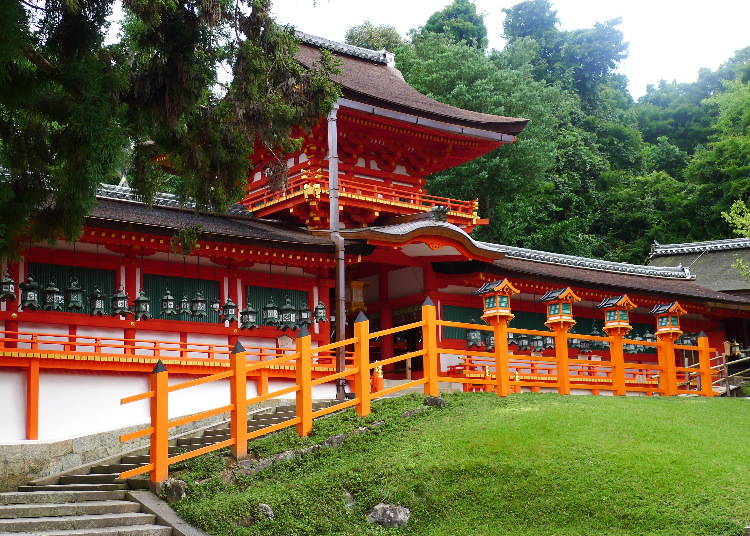
Just as much of a must-see spot as Todai-ji Temple is Kasuga Grand Shrine. The shrine's beginning starts around the time when the capital was established in Nara, when Takemikazuchi no Mikoto came to the peak of Mount Mikasa to pray for Japan's prosperity and its citizens' happiness. The shrine flourished as the place of worship for the Fujiwara clan's patron deity and earned the faith of not only the Imperial Court but also the common people. Ever since the shrine's establishment, Kasuga Taisha's vermillion pillars, white walls, and natural cypress bark roofs remain unchanged, standing in the Kasugano forest.
Deer are considered gods at Kasuga Grand Shrine, and you can see many on the vast premises of the shrine.
-

-
Address
160, Kasuganocho, Nara-shi, Nara, 630-8212
View Map -
Nearest Station
Nara Station (JR Kansai Main Line / JR Yamatoji Line / JR Sakurai Line)
11 minutes by car
- Phone Number 0742-22-7788
-
Address
160, Kasuganocho, Nara-shi, Nara, 630-8212
Take a Walk Through Naramachi's Historic Merchant Houses
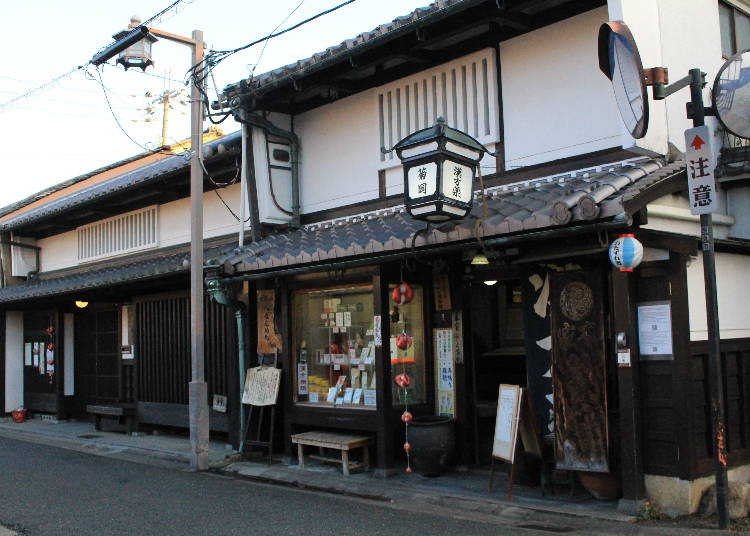
"Naramachi" is another popular tourist spot, with its charming merchant houses constructed beginning in the Edo period. Aside from the recreations of typical Edo period merchant house construction and the exhibitions of Naramachi historic materials, there are also merchant houses reformed into restaurants, cafes, and souvenir shops throughout the area. Even the narrow alleyways are filled with interesting sights.
-

-
Address
44, Gangojicho, Nara-shi, Nara, 630-8332
View Map -
Nearest Station
Kyobate Station (JR Sakurai Line)
8 minutes on foot
- Phone Number 0742-23-4820
-
Address
44, Gangojicho, Nara-shi, Nara, 630-8332
Persimmon-Leaf Sushi is the Leader of Nara Cuisin
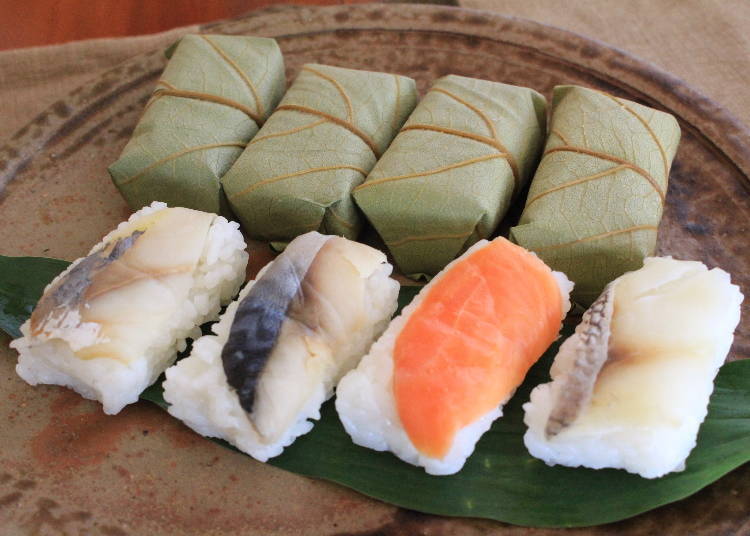
Kaki-no-ha sushi, or sushi wrapped in persimmon leaves, is one of Nara Prefecture's traditional dishes. Salt-marinated mackerel is placed atop bite-sized white rice portions and wrapped in persimmon leaves, then placed in a wooden box, pressed with a weight, and left to ferment for several days. The sushi spread in popularity as a preserved food in the times before refrigeration techniques were developed, and it was eaten as a special dish at festivals from summer through autumn in Nara Prefecture's mountain regions.
Today, most kaki-no-ha sushi is made with vinegar white rice, and the fermentation process is shortened. The most typical fish used is mackerel, but today you can get such sushi topped with salmon, sea bream, shrimp, eel, and other various ingredients.
Food and Japanese Confectionery Using Kuzu
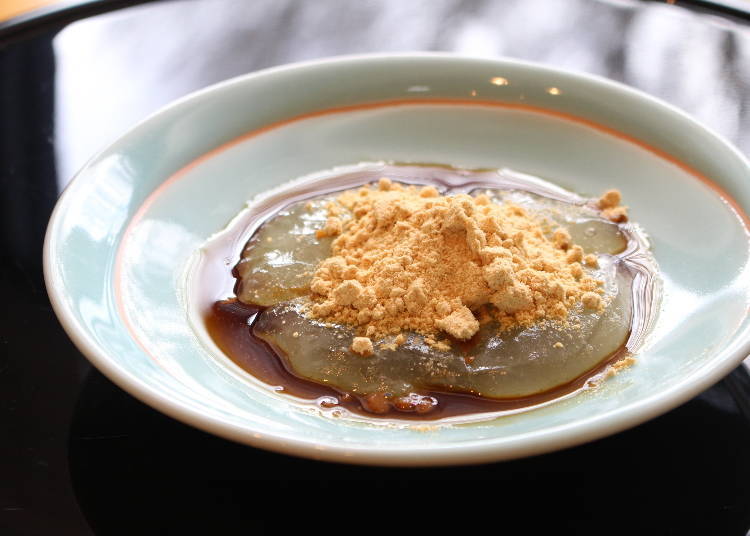
With the availability of high quality water and cold soil, the topography of the Yoshino region of Nara is ideal for the refinement of kuzuko, or arrowroot powder. The "yoshino hon-kuzu" powder made via the traditional "yoshino zarashi" method has a solid reputation for its high quality. The powder is incorporated into traditional dessert kuzukiri as well as various other kuzu sweets and dishes.
For Deer-Themed Goods, Go to "je et nous"
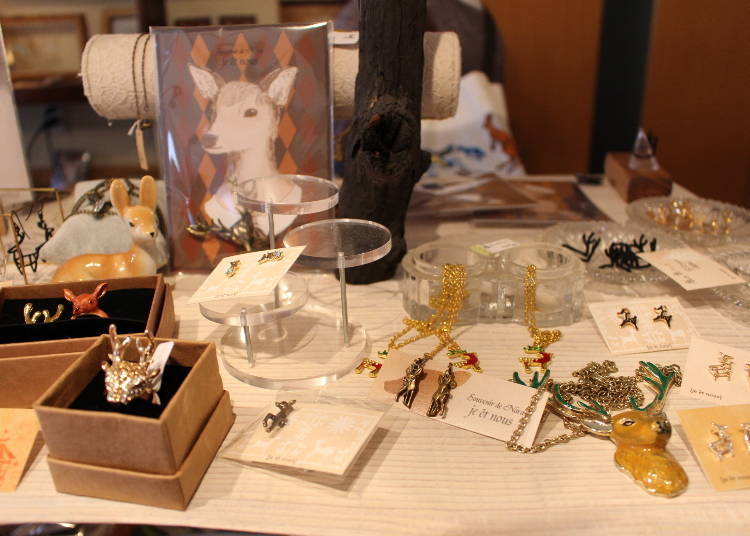
"je et nous" is a miscellaneous goods shop that carries second-hand chic deer items and original deer products from both within Japan and from overseas. From affordable stationary items like postcard and stamps to pricier accessories and decorative objects, there is a wide variety of items in stock. This shop is recommended for anyone who wants high-quality souvenirs. Most popular among international tourists are the vintage postcards. The shop's original map is also a big hit for them.
-
je et nousje et nous
- Address 53 Suimon-cho, Nara City, Nara
-
Nearest Station
53 Suimon-cho, Nara City, Nara
- Phone Number 0742-26-1868
Business Hours: 11:30 AM - 5:00 PM
Closed: every Monday and Tuesday
"Archaic", Packed with Deer Sweets Any Girl Will Love
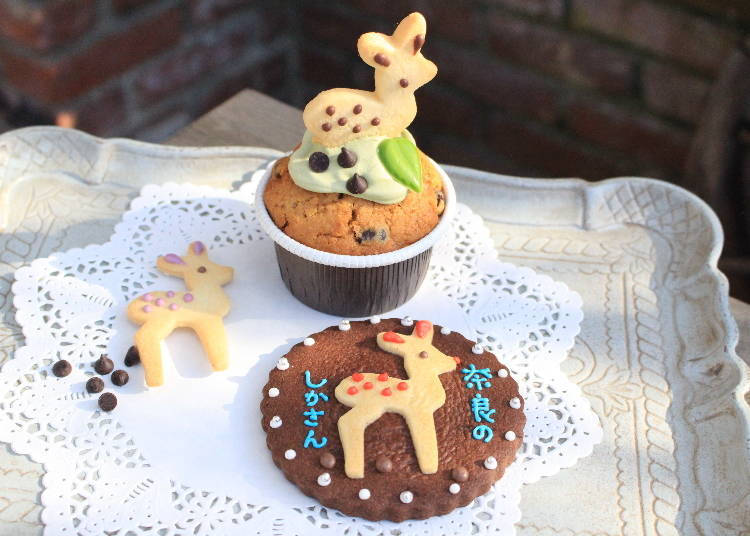
Here you will find plenty of adorable sweets that will bring joy to both giver and recipient. The store's most popular items are the deer cookies and "Nara Deer Muffins" topped with chocolate chip "deer droppings" (400 yen, tax included). The "Nara Deer Sable" cookies (480 yen, tax included) also feature cute deer images. Each dessert is hand-made with different expressions, so you'll be sure to want to take your personal favorite deer home with you.
-
Archaicアルカイック
- Address 44-1 Fukuchiin, Nara City, Nara
-
Nearest Station
4-7 minutes by Tenri-yuki bus from JR Yamatoji Line "Nara" Station or Kintetsu Nara Line "Kintestsu-Nara" Station and a short walk from "Fukuchiin-cho" bus stop, or a 19-minute walk from Kintetsu Nara Line "Nara" station
- Phone Number 0742-24-7007
Business Hours: 10:30 AM - 6:00 PM
Closed: every Wednesday
Book an unforgettable experience in Nara!
Make your trip extra memorable by booking one of these recommended tours.
Kiko Matsuda, Keiko Kimura, Risa Tsushi, and a team of female writers familiar with Kansai. We love eating, drinking and traveling! We share fun information based on our experiences.
- Area
- Category
*Prices and options mentioned are subject to change.
*Unless stated otherwise, all prices include tax.
Popular Tours & Activitiess
Recommended places for you
-

Jukuseiniku-to Namamottsuarera Nikubaru Italian Nikutaria Sannomiya
Izakaya
Kobe, Sannomiya, Kitano
-

Todai-ji Temple
Temples
Nara, Ikoma, Tenri
-

Kambei Sannomiyahonten
Yakiniku
Kobe, Sannomiya, Kitano
-

ISHIDAYA Hanare
Yakiniku
Kobe, Sannomiya, Kitano
-
Goods

Yoshida Gennojo-Roho Kyoto Buddhist Altars
Gift Shops
Nijo Castle, Kyoto Imperial Palace
-

Kanzenkoshitsuyakinikutabehodai Gyugyu Paradise Sannomiya
Yakiniku
Kobe, Sannomiya, Kitano
-

Kyoto's Hidden Treasures Open This Winter! Enjoy Exclusive Access to 15 Rare Cultural Sites (Jan-Mar 2026)
by: Guest Contributor
-

A First Look at NEMU RESORT’s 2026 Grand Renewal in Ise-Shima: A Resort Shaped by Village, Sea, and Forest
by: Guest Contributor
-

Celebrate a Dreamy Barbapapa Christmas at JR Osaka Station's Twilight
by: Guest Contributor
-

November Events in Kansai: Fun Festivals, Food, and Things to Do in Kyoto & Osaka
-
Ad

Experiencing Manga as Culture, Not Just Reading It: Expo 2025 with Rumiko Takahashi
-

New Way to Reach Koyasan! Ride Nankai's 'GRAN Tenku' for a Heavenly Journey
by: Guest Contributor
Inspiration for Accommodations
-

Spacious Family Hotel in Namba: 20 Comfortable Stays for Family Fun
-

Charming Hotels to Enjoy the Spectacular Views of Arashiyama's Autumn Leaves from Your Room
-

Experience Stunning Views of Osaka Castle from Private Spaces: Top Hotels Near Osaka Castle
-

Recommended by Visitors! Arashiyama's Best-Rated Hotels
-

Family-Friendly Universal Studios Japan Hotel with Excellent Access
-

Enjoy a Comfortable Stay in Osaka! 10 Hotels with Convenient Airport Shuttle Services
-

Top 10 Recommended Hotels Near Namba Station with Great Access
-

Enjoy Night Views from Your Room! Recommended Hotels in Namba Area
-

Can’t Get Where You’re Going in Kyoto? What do “Agaru” and “Sagaru” Mean? Kyoto’s Unique Address System!
-

5 Amazing Kyoto Festivals You’ll Want to Experience During Your Next Trip
-

Ninenzaka and Sannenzaka: Walking Guide to Kyoto's Best Old Streets
by: WESTPLAN
-

Hoshinoya Kyoto: This Incredible Japanese Hotel Welcomes You By Boat on a Sakura-Filled River
-

Kyoto Gion Walking Guide: Top 10 Must-See Areas for First-Time Visitors
-

Kichijoji – Explore Tokyo’s Top-Rated Stylish Suburb in Half a Day!
- #best gourmet Osaka
- #things to do Osaka
- #what to do in kyoto
- #what to bring to japan
- #best gourmet Kyoto
- #new years in Osaka
- #what to buy in nanba
- #Visiting Osaka
- #onsen tattoo friendly arima
- #daiso
- #Visiting Kyoto
- #best japanese soft drinks
- #japanese fashion culture
- #japanese convenience store snacks
- #japanese nail trends














